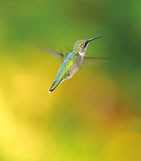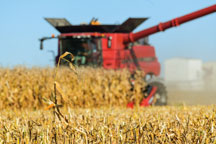Main Content
Article
Outdoor Indiana - May/June 2020 - Featured Stories
From the Director
'Flying jewels' kick butt as needed
Get paddling
Popcorn climbs in status
From the Director
 'A MILLION' TREES MEANS A MILLION
'A MILLION' TREES MEANS A MILLION
Most times you hear "a million," it's an exaggeration. It means a lot, but not 999,999 plus 1. The actual total is usually far less.
But when Gov. Holcomb announced in January that the state was going to plant a million trees, he meant it. Literally.
Under the direction of those who know the most about trees, our Division of Forestry, that effort is expected to take about five years.
The seedlings being planted, mostly red and white oaks, are and will continue to be grown at Vallonia State Tree Nursery from local seed. These species struggle to regenerate without assistance, and they probably have the largest impact on wildlife species, especially when it comes to serving as a food source.
Creation of this habitat greatly benefits humans, too. More forested land will stabilize erodible soils and help clean the air. More trees means more sequestering of carbon dioxide. In addition, the reflection of the sun by the additional green foliage created will help mitigate heat.
Wildlife will benefit from such planting in one or two years, by which time songbirds will start nesting. Making a significant impact in carbon storage is more long term, taking 10 years of growth or more from planting date.
It takes a lot of people to plant a million trees. Watch on.IN.gov/forestIN for events at which you can lend a hand.
With the expertise of our Forestry staff and help from the public, who knows? In this case a million might even turn out to be an understatement.
'Flying jewels' kick butt as needed
Lightweights are more than eye candy
By Phil Bloom
Having established his territory, he defends it against all intruders. It is his turf and his alone. It is here where he feeds. It is here where he breeds. Covetous gatecrashers enter at their own risk because he will fight hard to keep what's his.
 Who's responsible for this macho-man behavior?
Who's responsible for this macho-man behavior?
Hummingbirds.
Yes, hummingbirds.
Those frenetic flyers, whose average weight of 3 grams is the equivalent of six cotton balls, aren't afraid to mix it up when an uninvited visitor shows up. Hummingbirds are even known to take on crows, jays and hawks that venture too close.
Cutline: A young male ruby-throated hummingbird hovers near a feeder in late summer.
To read the rest of this article subscribe to Outdoor Indiana or pick up a copy at most Barnes and Noble bookstores, and state park inns. To subscribe, click here or call (317) 233-3046.
Get paddling
There's likely a boat to suit your desires and budget
By Scott Roberts, OI Staff
 Paddlers paddle for a number of reasons.
Paddlers paddle for a number of reasons.
Dan Plath, chief of resource management for Indiana Dunes National Park and a founding member of the Northwest Indiana Paddling Association (NWIPA), paddles Indiana's lakes, rivers and streams looking for tranquility.
"I love the connection with nature; I'm very much at peace when I'm on the water," Plath said. "It's the serenity of seeing things from a different perspective."
Steve Horney, founder of the Indiana chapter of the U.S. Canoe Association (USCA), a racing organization, paddles for the speed.
"If something moves, someone's going to race it," Horney said. "That person is me."
For those who want a different challenge, stand-up paddleboards (SUPs) require balance and strength, and give their users the flexibility to stand or lie on them.
Paddling has evolved to accommodate Plath and Horney's different preferences. Boats have gotten sturdier, faster, and able to carry more supplies, depending on the paddler's desires. More types of boats are available than ever before.
Cutline: Canoeists paddle Mill Creek toward Spring Mill State Park's lake. A 2019 survey showed 22.9 million people in the U.S. participated in a paddling activity during 2018.
To read the rest of this article subscribe to Outdoor Indiana or pick up a copy at most Barnes and Noble bookstores, and state park inns. To subscribe, click here or call (317) 233-3046.
Popcorn climbs in status
Taking snacking's center stage
By Scott Roberts, OI staff
 Popcorn usually shuns the limelight.
Popcorn usually shuns the limelight.
Chances are you don't think about it as you stuff handfuls in your mouth as you watch a movie or other entertainment.
The snack's ability to stay in the background is one reason popcorn is a near-perfect complement to many social functions all around the country. It can be dressed up with toppings or eaten plain. It's a good-tasting afterthought in most cases, part of creating a welcoming mood.
But Hoosiers have pushed the snack to the forefront, and with good reason. From seed to kernel, there's a good chance that no matter where you find popcorn, Indiana has played a part.
Cutline: Popcorn being harvested during fall in the Pulaski County fields surrounding Francesville in northern Indiana, home of Gutwein Gourmet Popping Corn. The Gutwein family started its popcorn business in 1998. Photo by Frank Oliver.
To read the rest of this article subscribe to Outdoor Indiana or pick up a copy at most Barnes and Noble bookstores, and state park inns. To subscribe, click here or call (317) 233-3046.
